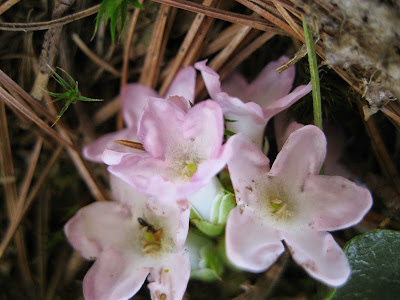Friday, May 8, 2015
Sex Amongst Arbutus
Our weather's sudden and dramatic shift from cold with deep snow cover to hot and dry has had an impact on all of the early flowers. Every day finds a different appearance displayed by the arbutus. The first picture shows the female's pollen collecting apparatus open, extended, and ready to receive pollen. What first appeared as a light green dome at the base of the blossom has pushed out and opened displaying a five pointed star. Five is a frequently repeated number for this plant. Five petals, a five pointed star, and a five sectioned seed berry if all goes well.
This is how the male flowers look on the same day as the first picture. Here the base of the blossom shows five paired pollen producing structures. When the flowers first open, the difference in color at the base of the flower is the most reliable identifying clue. Green is for girl while brown points to boy.
Interior flower parts soon show the impacts of heavy foot traffic. An ant is in the picture but we have also seen small bumble bees and other unidentified crawling insects in the open flowers. Some individual flowers have presented a confusing appearance since both male parts and female parts were present in a single blossom or on a single plant. Speculation suggests hungry ants biting off pieces and carrying parts about dropping them here and there.
This mature female flower shows a heavy coating of golden tan pollen that was trapped and held by the numerous hairs the line its tube. We know the exact location of this flower and expect to find a seed berry here shortly.
At first glance, I was troubled by all of the flowers that were no longer attached to this plant. A hand lens revealed the exposed pollen collecting structure stained a golden tan. We hope that timely applied pollen caused the discoloration. So now we watch and wait. Seed berries may form here. Since nothing has yet to appear where we scattered seed last year, perhaps we will try William Cullina's method for treating arbutus seed as a greenhouse object. That decision need not be made today. Still wildly working male flowers, not knowing that the female flowers have moved on to their next petal-less reproductive step, are now our only source of the intoxicating arbutus scent. It is amazing the speed with which these plants have completed their reproductive activity. Despite my daily visits to these plants, I have yet to see the yellow pollen shown in a William Cullina photo. Perhaps next year's possibly more normal weather will allow the plants to complete a leisurely reproductive path and I will finally see yellow arbutus pollen.
Subscribe to:
Post Comments (Atom)





No comments:
Post a Comment